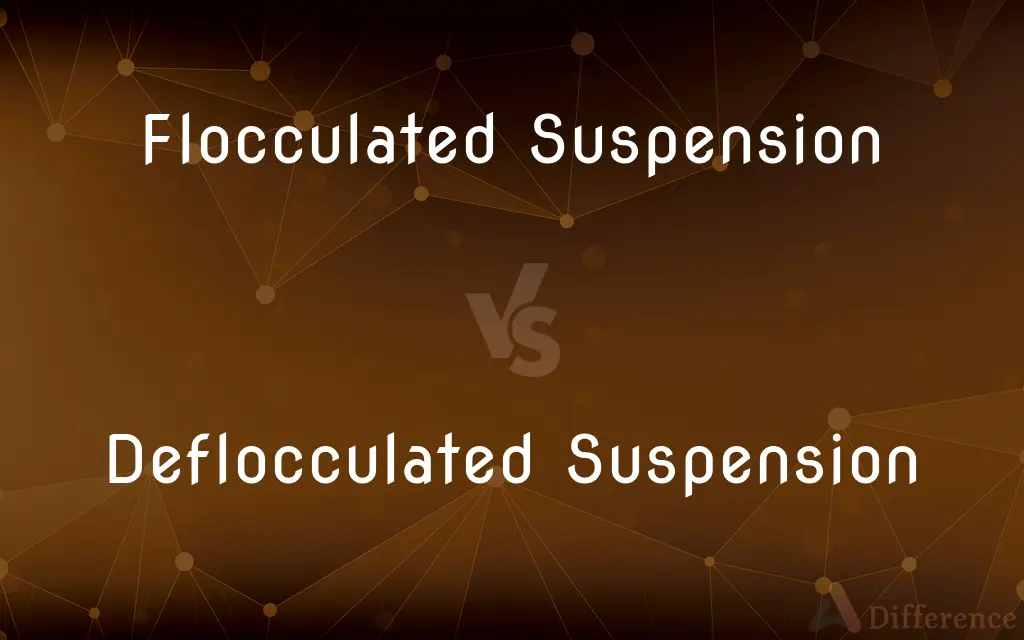Flocculated Suspension vs. Deflocculated Suspension — What's the Difference?
Edited by Tayyaba Rehman — By Fiza Rafique — Published on December 9, 2023
A Flocculated Suspension has aggregated particles forming clumps; a Deflocculated Suspension has dispersed particles that don't clump together. Both are systems of undissolved particles in a fluid.

Difference Between Flocculated Suspension and Deflocculated Suspension
Table of Contents
ADVERTISEMENT
Key Differences
A Flocculated Suspension refers to a state where the particles within a suspension aggregate, forming loose clusters or clumps known as flocs. These flocs come together due to weak van der Waals forces, leading to the creation of larger entities that settle rapidly. On the contrary, a Deflocculated Suspension is characterized by particles that remain individually dispersed and resist forming aggregates. This is due to the repulsive forces between the particles, ensuring they remain separate.
Flocculated Suspensions typically exhibit a clear liquid supernatant above the settled particles, as the formation of flocs causes rapid settling. This is in stark contrast to Deflocculated Suspensions, where the particles are uniformly distributed, leading to an even appearance without a clear supernatant layer.
The behavior of a Flocculated Suspension under sedimentation is distinctive; they exhibit a higher rate of sedimentation but form a porous sediment. Deflocculated Suspensions, meanwhile, settle slowly and produce a compact, hard sediment due to the closeness of the particles.
In terms of redispersibility, a Flocculated Suspension can be easily redispersed upon shaking. This is because the forces holding the particles together in flocs are weak. However, a Deflocculated Suspension, once settled, is difficult to redisperse due to the strong repulsive forces that originally kept the particles apart.
When it comes to stability, Flocculated Suspensions are generally considered less stable as they can lead to larger aggregates or even cause caking upon prolonged standing. Deflocculated Suspensions are more stable in this aspect, as the particles tend to resist aggregation.
ADVERTISEMENT
Comparison Chart
Particle Behavior
Aggregate to form flocs
Stay individually dispersed
Appearance
Clear supernatant layer above settled particles
Uniform without a clear supernatant layer
Sediment Type
Porous
Compact, hard
Redispersibility
Easily redispersible
Difficult to redisperse
Stability
Generally less stable
More stable
Compare with Definitions
Flocculated Suspension
A system where weak forces cause particle clustering.
The introduction of a flocculating agent led to a Flocculated Suspension.
Deflocculated Suspension
A suspension system exhibiting slow sedimentation and high stability.
The Deflocculated Suspension retained its appearance even after days of standing.
Flocculated Suspension
A suspension characterized by rapid settling due to particle aggregation.
The Flocculated Suspension displayed a clear layer atop the sediment.
Deflocculated Suspension
A suspension where particles remain individually dispersed.
The consistency of the liquid indicated a Deflocculated Suspension.
Flocculated Suspension
A state in which suspended particles aggregate together.
The suspension turned cloudy indicating a Flocculated Suspension.
Deflocculated Suspension
A state where repulsive forces prevent particle aggregation.
The addition of the stabilizer maintained a Deflocculated Suspension.
Flocculated Suspension
Suspended particles that come together to form flocs.
The gelatin created a Flocculated Suspension when mixed in the solution.
Deflocculated Suspension
Suspended particles resist clustering due to strong inter-particle repulsion.
The solution remained uniform, suggesting a Deflocculated Suspension.
Flocculated Suspension
A suspension where particles form loose clusters.
The rapid settling observed was due to the formation of a Flocculated Suspension.
Deflocculated Suspension
Particles in the liquid are uniformly spread without forming clusters.
A Deflocculated Suspension ensures a smooth texture in pharmaceutical formulations.
Common Curiosities
Which suspension type shows a clear supernatant layer?
Flocculated Suspension often exhibits this due to rapid settling of particles.
What causes the formation of a Flocculated Suspension?
Weak forces like van der Waals cause particles to aggregate into flocs.
Why might a Deflocculated Suspension be preferred in some applications?
It's more stable and produces a uniform, smooth texture.
Is a Flocculated Suspension easily redispersible?
Yes, because the forces holding particles in flocs are weak.
How do particles behave in a Deflocculated Suspension?
They remain individually dispersed due to repulsive forces.
Which suspension settles faster?
Flocculated Suspension due to particle aggregation.
Can the addition of certain agents induce flocculation?
Yes, flocculating agents can turn a stable suspension into a Flocculated Suspension.
Can a Flocculated Suspension turn into a Deflocculated Suspension?
Yes, with the addition of deflocculating agents or changing conditions.
Why is a Deflocculated Suspension considered more stable?
Because the particles resist aggregation and remain uniformly dispersed.
How can one identify a Flocculated Suspension visually?
By the rapid settling of particles and a clear supernatant layer.
Are there industrial applications where one type of suspension is favored over the other?
Yes, depending on the desired product attributes, either Flocculated or Deflocculated Suspension might be preferred.
What type of sediment does a Flocculated Suspension form?
A porous sediment due to the loosely aggregated particles.
Why is redispersing a Deflocculated Suspension challenging?
Due to strong repulsive forces that originally kept particles apart.
What type of sediment is formed by a Deflocculated Suspension?
A compact, hard sediment due to closely packed particles.
What's the main disadvantage of a Flocculated Suspension?
It's generally less stable and can form larger aggregates or cake upon standing.
Share Your Discovery

Previous Comparison
Visa vs. Solo
Next Comparison
ASPCA vs. HSUSAuthor Spotlight
Written by
Fiza RafiqueFiza Rafique is a skilled content writer at AskDifference.com, where she meticulously refines and enhances written pieces. Drawing from her vast editorial expertise, Fiza ensures clarity, accuracy, and precision in every article. Passionate about language, she continually seeks to elevate the quality of content for readers worldwide.
Edited by
Tayyaba RehmanTayyaba Rehman is a distinguished writer, currently serving as a primary contributor to askdifference.com. As a researcher in semantics and etymology, Tayyaba's passion for the complexity of languages and their distinctions has found a perfect home on the platform. Tayyaba delves into the intricacies of language, distinguishing between commonly confused words and phrases, thereby providing clarity for readers worldwide.













































